Application of Capillary Electrophoresis for Determination of Inorganic Analytes in Waters
Abstract
1. Introduction
2. Basic Modes of Analytical Capillary Electrophoresis Measurements
3. Application of Different Detection Methods
3.1. Application of UV Detection
3.2. Luminescence-Based Detection Methods
3.3. Electrochemical Detection Methods
3.4. Mass Spectrometry Detection
3.5. Atomic Spectrometry Detection
4. Sample Processing in CE Systems for Water Analysis
4.1. Off-Line Sample Processing
4.2. On-Line (In-Capillary) Pretreatment Operations
5. Simultaneous Determination of Anions and Cations
6. Conclusions and Perspectives
Author Contributions
Funding
Conflicts of Interest
References
- Viratanen, R. Zone electrophoresis in a narrow-bore tube employing potentiometric detection—Theoretical and experimental study. Acta Polyt. Scand. Chem. Incl. Metall. Ser. 1974, 123, 1–67. [Google Scholar]
- Jorgenson, J.W.; Lukacs, K.D. Zone electrophoresis in open-tubular glass capillaries. Anal. Chem. 1981, 53, 1298–1302. [Google Scholar] [CrossRef]
- Voeten, R.L.; Ventouri, I.K.; Haselberg, R.; Somsen, G.W. Capillary electrophoresis: Trends and recent advances. Anal. Chem. 2018, 90, 1464–1481. [Google Scholar] [CrossRef] [PubMed]
- Choi, O.-K.; Cho, J.-S. Analysis of inorganic anions in various drinking waters by capillary electrophoresis. Anal. Sci. Technol. 1995, 8, 835–841. [Google Scholar]
- Haddad, P.R. Comparison of ion chromatography and capillary electrophoresis for the determination of inorganic ions. J. Chromatogr. A 1997, 770, 281–290. [Google Scholar] [CrossRef]
- Pacakova, V.; Stulik, K. Capillary electrophoresis of inorganic anions and its comparison with ion chromatography. J. Chromatogr. A 1997, 789, 169–180. [Google Scholar] [CrossRef]
- Breadmore, M.C. Capillary and microchip electrophoresis: Challenging the common conceptions. J. Chromatogr. A 2012, 1221, 42–55. [Google Scholar] [CrossRef]
- Torres, N.T.; Hauser, P.C.; Furrer, G.; Brandl, H.; Muller, B. Sediment porewater extraction and analysis combining filter tube samplers and capillary electrophoresis. Environ. Sci. Process. Impacts 2013, 15, 715–720. [Google Scholar] [CrossRef]
- Timerbaev, A.R. Recent advances and trends in capillary electrophoresis of inorganic ions. Electrophoresis 2002, 23, 3884–3906. [Google Scholar] [CrossRef]
- Timerbaev, A.R. Capillary electrophoresis of inorganic ions: An update. Electrophoresis 2004, 25, 4008–4031. [Google Scholar] [CrossRef]
- Kubáň, P.; Timerbaev, A.R. Inorganic analysis using CE: Advanced methodologies to face old challenges. Electrophoresis 2014, 35, 225–233. [Google Scholar] [CrossRef]
- Mala, Z.; Gebauer, P. Recent progress in analytical capillary isotachophoresis. Electrophoresis 2019, 40, 55–64. [Google Scholar] [CrossRef]
- Fukushi, K.; Takeda, S.; Chayama, K.; Walida, S. Application of capillary electrophoresis to the analysis of inorganic ions in environmental samples. J. Chromatogr. A 1999, 834, 349–362. [Google Scholar] [CrossRef]
- Valsecchi, S.M.; Polsello, S. Analysis of inorganic species in environmental samples by capillary electrophoresis. J. Chromatogr. A 1999, 834, 363–385. [Google Scholar] [CrossRef]
- Ali, I.; Aboul-Enein, H.Y. Determination of metal ions in water, soil and sediment by capillary electrophoresis. Anal. Lett. 2002, 35, 2053–2076. [Google Scholar] [CrossRef]
- Lewis, A.P.; Cranny, A.; Harris, N.R.; Green, N.G.; Wharton, J.A.; Wood, R.J.K.; Stokes, K.R. Review on the development of truly portable and in-situ capillary electrophoresis systems. Meas. Sci. Technol. 2013, 24, 042001. [Google Scholar] [CrossRef]
- El Fellah, S.; Duporté, G.; Sirén, H. Steroid hormones, inorganic ions and botrydial in drinking water. Determination with capillary electrophoresis and liquid chromatography-orbitrap high resolution mass spectrometry. Microchem. J. 2017, 133, 126–136. [Google Scholar] [CrossRef]
- Kowalski, P.; Olędzka, I.; Plenis, A.; Bączek, T. Dynamic double coating, electrophoretic method with indirect detection for the simultaneous quantification of mono- and divalent cations in various water samples. Electrophoresis 2017, 38, 477–485. [Google Scholar] [CrossRef]
- Varden, L.; Bou-Abdallah, F. Detection and separation of inorganic cations in natural, potable, and wastewater samples using capillary zone electrophoresis with indirect UV detection. Am. J. Analyt. Chem. 2017, 8, 81–94. [Google Scholar] [CrossRef][Green Version]
- Lancioni, C.; Aspromonte, J.; Tascon, M.; Gagliardi, L.G. Development of a background electrolyte for the determination of inorganic cations in high ionic strength samples by capillary electrophoresis with indirect UV-absorption detection. J. Chromatogr. A 2021, 1645, 462091. [Google Scholar] [CrossRef]
- Pappoe, M.; Bottaro, C.S. Systematic optimization of a pyromellitic acid background electrolyte for capillary electrophoresis with indirect UV-vis detection and online preconcentration analysis of thiosalt anions in treated mine tailings. Anal. Meth. 2014, 6, 9305–9312. [Google Scholar] [CrossRef]
- Donkor, K.K.; Guo, Z.C.; Soliman, L.C.; Law, Y.T.; Risley, J.M.; Schmidt, K.J.; Crabtree, H.J.; Warrender, N.A. Determination of sulfate and chloride ions in highly saline oilfield water by capillary electrophoresis using bilayer-coated capillaries and indirect absorption detection. Intern. J. Environ. Anal. Chem. 2015, 95, 175–186. [Google Scholar] [CrossRef]
- Wang, Q.-P.; Chen, Z.-L.; Chen, G.-N.; Lin, J.-M. Simultaneous determination of phosphate and calcium in river water samples by capillary zone electrophoresis with UV detection. Intern. J. Environ. Anal. Chem. 2011, 91, 255–262. [Google Scholar] [CrossRef]
- Marák, J.; Staňová, A.; Vaváková, V.; Hrenáková, M.; Kaniansky, D. On-line capillary isotachophoresis–capillary zone electrophoresis analysis of bromate in drinking waters in an automated analyzer with coupled columns and photometric detection. J. Chromatogr. A 2012, 1267, 252–258. [Google Scholar] [CrossRef]
- Guo, Y.; Xu, F.; Meng, L.; Tang, W.; Xia, Y.; Wu, Y.; Zhang, S. Preparation and application of trimethylamine amination polychloromethyl styrene nanolatex coated capillary column for the determination of bromate by field-amplified sample stacking open-tubular capillary electrochromatography. Electrophoresis 2013, 34, 1312–1318. [Google Scholar] [CrossRef]
- Fukushi, K.; Fujita, Y.; Nonogaki, J.; Tsujimoto, J.; Hattori, T.; Inui, H.; Beškoski, V.P.; Hotta, H.; Hayashi, M.; Nakano, T. Capillary zone electrophoresis determination of fluoride in seawater using transient isotachophoresis. Anal. Bioanal. Chem. 2018, 410, 1825–1831. [Google Scholar] [CrossRef]
- Yang, F.; Li, J.; Lu, W.; Wen, Y.; Cai, X.; You, J.; Ma, J.; Ding, Y.; Chen, L. Speciation analysis of mercury in water samples by dispersive liquid–liquid microextraction coupled to capillary electrophoresis. Electrophoresis 2014, 35, 474–481. [Google Scholar] [CrossRef]
- Li, P.; He, M.; Chen, B.; Hu, B. Automated dynamic hollow fiber liquid–liquid–liquid microextraction combined with capillary electrophoresis for speciation of mercury in biological and environmental samples. J. Chromatogr. A 2015, 1415, 48–56. [Google Scholar] [CrossRef]
- Li, P.; Zhang, X.; Hu, B. Phase transfer membrane supported liquid–liquid–liquid microextraction combined with large volume sample injection capillary electrophoresis–ultraviolet detection for the speciation of inorganic and organic mercury. J. Chromatogr. A 2011, 1218, 9414–9421. [Google Scholar] [CrossRef] [PubMed]
- Chen, C.; Peng, M.; Hou, X.; Zheng, C.; Long, Z. Improved hollow fiber supported liquid–liquid–liquid membrane microextraction for speciation of inorganic and organic mercury by capillary electrophoresis. Anal. Methods 2013, 5, 1185–1191. [Google Scholar] [CrossRef]
- Duan, J.; Hu, B.; He, M. Nanometer-sized alumina packed microcolumn solid-phase extraction combined with field-amplified sample stacking-capillary electrophoresis for the speciation analysis of inorganic selenium in environmental water samples. Electrophoresis 2012, 33, 2953–2960. [Google Scholar] [CrossRef] [PubMed]
- Cheng, K.; Choi, K.; Kim, J.; Sung, I.-H.; Chung, D.S. Sensitive arsenic analysis by carrier-mediated counter-transport single drop microextraction coupled with capillary electrophoresis. Microchem. J. 2013, 106, 220–225. [Google Scholar] [CrossRef]
- Lee, H.G.; Kwon, J.Y.; Chung, D.S. Sensitive arsenic speciation by capillary electrophoresis using UV absorbance detection with on-line sample preconcentration techniques. Talanta 2018, 181, 366–372. [Google Scholar] [CrossRef]
- Saito, S.; Nakano, Y.; Hikichi, A.; Suzuki, R.; Yoshimoto, K.; Maeda, M.; Aoyamab, M.; Shibukawa, M. Ultrasensitive CE for heavy metal ions using the variations in the chemical structures formed from new octadentate fluorescent probes and cationic polymers. Analyst 2011, 136, 2697–2707. [Google Scholar] [CrossRef]
- Pei, L.; Schmidt, K.J.; Crabtree, H.J.; Lucy, C.A. Determination of inorganic anions in oilfield water using capillary electrophoresis with indirect fluorescence detection. Anal. Methods 2015, 7, 8689–8696. [Google Scholar] [CrossRef]
- Trojanowicz, M. Recent developments in electrochemical flow detections—A Review, Part I. Flow analysis and capillary electrophoresis. Anal. Chim. Acta 2009, 653, 36–58. [Google Scholar] [CrossRef]
- Zemann, A.J.; Schnell, E.; Volgger, D.; Bonn, G.K. Contactless conductivity detection for capillary electrophoresis. Anal. Chem. 1998, 70, 563–567. [Google Scholar] [CrossRef]
- Da Silva, J.A.F.; Do Lago, C.L. An oscillometric detector for capillary electrophoresis. Anal. Chem. 1998, 70, 4339–4343. [Google Scholar] [CrossRef]
- Kubáň, P.; Hauser, P.C. Contactless conductivity detection for analytical techniques—Developments from 2014 to 2016. Electrophoresis 2017, 38, 95–114. [Google Scholar] [CrossRef] [PubMed]
- Kubáň, P.; Hauser, P.C. 20th anniversary of axial capacitively coupled contactless conductivity detection in capillary electrophoresis. Trends Anal. Chem. 2018, 102, 311–321. [Google Scholar] [CrossRef]
- Silva, M.; Mendiguchía, C.; Moreno, C.; Kubáň, P. Electromembrane extraction and capillary electrophoresis with capacitively coupled contactless conductivity detection: Multi-extraction capabilities to analyses trace metals from saline samples. Electrophoresis 2018, 39, 2152–2159. [Google Scholar] [CrossRef]
- Ferreira Santos, M.S.; Cordeiro, T.G.; Noell, A.C.; Garcia, C.D.; Mora, M.F. Analysis of inorganic cations and amino acids in high salinity samples by capillary electrophoresis and conductivity detection: Implications for in-situ exploration of ocean worlds. Electrophoresis 2018, 39, 2890–2897. [Google Scholar] [CrossRef]
- Kubáň, P.; Boček, P. Preconcentration in micro-electromembrane extraction across free liquid membranes. Anal. Chim. Acta 2014, 848, 43–50. [Google Scholar] [CrossRef] [PubMed]
- Opekar, F.; Tůma, P. Dual-channel capillary electrophoresis for simultaneous determination of cations and anions. J. Chromatogr. A 2016, 1446, 158–163. [Google Scholar] [CrossRef]
- Zhang, X.; Guo, L.; Zhang, D.; Ge, X.; Ye, J.; Chu, Q. Sensitive determination of bromate in water samples by capillary electrophoresis coupled with electromembrane extraction. Food Anal. Methods 2016, 9, 393–400. [Google Scholar] [CrossRef]
- Kuban, P.; Strieglerova, L.; Gebauer, P.; Bocek, P. Electromembrane extraction of heavy metal cations followed by capillary electrophoresis with capacitively coupled contactless conductivity detection. Electrophoresis 2011, 32, 1025–1032. [Google Scholar] [CrossRef] [PubMed]
- Duong, H.A.; Le, M.D.; Nguyen, K.D.M.; Hauser, P.C.; Pham, H.V.; Mai, T.D. In-house-made capillary electrophoresis instruments coupled with contactless conductivity detection as a simple and inexpensive solution for water analysis: A case study in Vietnam. Environ. Sci. Process. Impacts 2015, 17, 1941–1951. [Google Scholar] [CrossRef] [PubMed]
- Mai, T.D.; Schmid, S.; Muller, B.; Hauser, P.C. Capillary electrophoresis with contactless conductivity detection coupled to a sequential injection analysis manifold for extended automated monitoring applications. Anal. Chim. Acta 2010, 665, 1–6. [Google Scholar] [CrossRef]
- Mai, T.D.; Le, M.D.; Sáiz, J.; Duong, H.A.; Koenka, I.J.; Pham, H.V.; Hauser, P.C. Triple-channel portable capillary electrophoresis instrument with individual background electrolytes for the concurrent separations of anionic and cationic species. Anal. Chim. Acta 2016, 911, 121–128. [Google Scholar] [CrossRef] [PubMed]
- Mai, T.D.; Pham, T.T.T.; Pham, H.V.; Sáiz, J.; Ruiz, C.G.; Hauser, P.C. Portable capillary electrophoresis instrument with automated injector and contactless conductivity detection. Anal. Chem. 2013, 85, 2333–2339. [Google Scholar] [CrossRef]
- Sáiz, J.; Koenka, I.J.; Garćıa-Ruiz, C.; Müller, B.; Chwalek, T.; Hauser, P.C. Micro-injector for capillary electrophoresis. Electrophoresis 2015, 36, 1941–1944. [Google Scholar] [CrossRef]
- Torres, N.T.; Och, L.M.; Hauser, P.C.; Furrer, G.; Brandl, H.; Vologina, E.; Sturm, M.; Burgmanna, H.; Muller, B. Early diagenetic processes generate iron and manganese oxide layers in the sediments of Lake Baikal, Siberia. Environ. Sci. Process. Impacts 2014, 16, 879–889. [Google Scholar] [CrossRef] [PubMed]
- Kiplagat, I.K.; Doan, T.K.O.; Kubáň, P.; Boček, P. Trace determination of perchlorate using electromembrane extraction and capillary electrophoresis with capacitively coupled contactless conductivity detection. Electrophoresis 2011, 32, 3008–3015. [Google Scholar] [CrossRef]
- Gaudry, A.J.; Guijt, R.M.; Mack, M.; Hutchinson, J.P.; Johns, C.; Hilder, E.F.; Dicinoski, G.W.; Nesterenko, P.N.; Haddad, P.R.; Breadmore, M.C. On-line simultaneous and rapid separation of anions and cations from a single sample using dual-capillary sequential injection-capillary electrophoresis. Anal. Chim. Acta 2013, 781, 80–87. [Google Scholar] [CrossRef] [PubMed]
- Pham, T.T.T.; Mai, T.D.; Nguyen, T.D.; Sáiz, J.; Pham, H.V.; Hauser, P.C. Automated dual capillary electrophoresis system with hydrodynamic injection for the concurrent determination of cations and anions. Anal. Chim. Acta 2014, 841, 77–83. [Google Scholar] [CrossRef]
- Koenka, I.J.; Mai, T.D.; Hauser, P.C.; Sáiz, J. Simultaneous separation of cations and anions in capillary electrophoresis—Recent applications. Anal. Methods 2016, 8, 1452–1456. [Google Scholar] [CrossRef]
- Flanigan, P.M.; Ross, D.; Shackman, J.G. Determination of inorganic ions in mineral water by gradient elution moving boundary electrophoresis. Electrophoresis 2010, 31, 3466–3474. [Google Scholar] [CrossRef]
- Mai, T.D.; Hauser, P.C. Simultaneous separations of cations and anions by capillary electrophoresis with contactless conductivity detection employing a sequential injection analysis manifold for flexible manipulation of sample plugs. J. Chromatogr. A 2012, 1267, 266–272. [Google Scholar] [CrossRef]
- Liu, S.; Pan, Z.; Liang, Y.; Li, F.; Breadmore, M.C.; Zhang, M. An electrophoretic ion analyzer for on-site autonomous water monitoring. J. Chromatogr. A 2021, 1637, 461791. [Google Scholar] [CrossRef] [PubMed]
- Nakatani, N.; Cabot, J.M.; Lam, S.C.; Rodriguez, E.S.; Paull, B. Selective capillary electrophoresis separation of mono and divalent cations within a high-surface area-to-volume ratio multi-lumen capillary. Anal. Chim. Acta 2019, 1051, 41–48. [Google Scholar] [CrossRef]
- Fuiko, R.; Saracevic, E.; Koenka, I.J.; Hauser, P.C.; Krampe, J. Capillary electrophoresis for continuous nitrogen quantification in wastewater treatment processes. Talanta 2019, 195, 366–371. [Google Scholar] [CrossRef]
- Neaga, I.-O.; Iacob, B.C.; Bodoki, E. The analysis of small ions with physiological implications using capillary electrophoresis with contactless conductivity detection. J. Liq. Chromatogr. Relat. Technol. 2014, 37, 2072–2090. [Google Scholar] [CrossRef]
- Koenka, I.J.; Kung, N.; Kuban, P.; Chwalek, T.; Furrer, G.; Wehrli, B.; Muller, B.; Hauser, P.C. Thermostated dual-channel portable capillary electrophoresis instrument. Electrophoresis 2016, 37, 2368–2375. [Google Scholar] [CrossRef]
- Tian, Z.; Qin, W. Capillary electrophoretic separation of anions in dimethylformamide–acetic acid medium. Anal. Methods 2014, 6, 5353–5359. [Google Scholar] [CrossRef]
- Chen, Y.; Cheng, X.; Mo, F.; Huang, L.; Wu, Z.; Wu, Y.; Xu, L.; Fu, F. Ultra-sensitive speciation analysis of mercury by CE-ICP-MS together with field-amplified sample stacking injection and dispersive solid-phase extraction. Electrophoresis 2016, 37, 1055–1062. [Google Scholar] [CrossRef] [PubMed]
- Li, B.-H. Rapid speciation analysis of mercury by short column capillary electrophoresis on-line coupled with inductively coupled plasma mass spectrometry. Anal. Methods 2011, 3, 116–121. [Google Scholar] [CrossRef]
- Liu, L.; He, B.; Yun, Z.; Sun, J.; Jiang, G. Speciation analysis of arsenic compounds by capillary electrophoresis on-line coupled with inductively coupled plasma mass spectrometry using a novel interface. J. Chromatogr. A 2013, 1304, 227–233. [Google Scholar] [CrossRef] [PubMed]
- Liu, L.; Yun, Z.; He, B.; Jiang, G. Efficient interface for online coupling of capillary electrophoresis with inductively coupled plasma—Mass spectrometry and its application in simultaneous speciation analysis of arsenic and selenium. Anal. Chem. 2014, 86, 8167–8175. [Google Scholar] [CrossRef]
- Zhou, D.; Lin, Y.; Long, H.; Xu, Y.; Wang, B.; Xian, L.; Xia, C.H.; Hou, X.; Zheng, C.h. Simultaneous total and speciation analysis of rhenium by capillary electrophoresis-inductively coupled plasma mass spectrometry. Spectrochim. Acta Part B Atmo. Spectrosc. 2021, 180, 106211. [Google Scholar] [CrossRef]
- Dominguez-Alvarez, J. Capillary electrophoresis coupled to electrospray mass spectrometry for the determination of organic and inorganic arsenic compounds in water samples. Talanta 2020, 212, 120803. [Google Scholar] [CrossRef]
- Zhang, H.; Gavina, J.; Feng, Y.-L. Understanding mechanisms of pressure-assisted electrokinetic injection: Application to analysis of bromate, arsenic and selenium species in drinking water by capillary electrophoresis-mass spectrometry. J. Chromatogr. A 2011, 1218, 3095–3104. [Google Scholar] [CrossRef]
- Gaspar, A.; Pesti, A.; Szabo, M.; Kecskemeti, A. Determination of chlorine species by capillary electrophoresis—Mass spectrometry. Electrophoresis 2019, 40, 2637–2643. [Google Scholar] [CrossRef] [PubMed]
- Yan, L.; Deng, B.; Shen, C.; Long, C.; Deng, Q.; Tao, C. Selenium speciation using capillary electrophoresis coupled with modified electrothermal atomic absorption spectrometry after selective extraction with 5-sulfosalicylic acid functionalized magnetic nanoparticles. J. Chromatogr. A 2015, 1395, 173–179. [Google Scholar] [CrossRef] [PubMed]
- Deng, B.; Qin, X.; Xiao, Y.; Wang, Y.; Yin, H.; Xu, X.; Shen, C. Interface of on line coupling capillary electrophoresis with hydride generation electrothermal atomic absorption spectrometry and its application to arsenic speciation in sediment. Talanta 2013, 109, 128–132. [Google Scholar] [CrossRef] [PubMed]
- Huang, C.H.; Chen, Z.; Gjelstad, A.; Pedersen-Bjergaard, S.; Shen, X. Electromembrane extraction. Trends Anal. Chem. 2017, 95, 47–56. [Google Scholar] [CrossRef]
- Oedit, A.; Ramautar, R.; Hankemeier, T.; Lindenburg, P.W. Electroextraction and electromembrane extraction: Advances in hyphenation to analytical techniques. Electrophoresis 2016, 37, 1170–1186. [Google Scholar] [CrossRef] [PubMed]
- Choi, K.; Kim, S.J.; Jin, Y.G.; Jang, Y.O.; Kim, J.S.; Chung, D.S. Single drop microextraction using commercial capillary electrophoresis instruments. Anal. Chem. 2009, 81, 225–230. [Google Scholar] [CrossRef]
- Alothman, Z.A.; Dawod, M.; Kim, J.; Chung, D.S. Single-drop microextraction as a powerful pretreatment tool for capillary electrophoresis: A review. Anal. Chim. Acta 2012, 739, 14–24. [Google Scholar] [CrossRef]
- Ranjbar, L.; Gaudry, A.J.; Breadmore, M.C.; Shellie, R.A. Online comprehensive two-dimensional ion chromatography × capillary electrophoresis. Anal. Chem. 2015, 87, 8673–8678. [Google Scholar] [CrossRef]
- Meng, H.-B.; Wang, T.-R.; Guo, B.-Y.; Hashi, Y.; Guo, C.-X.; Lin, J.-M. Simultaneous determination of inorganic anions and cations in explosive residues by ion chromatography. Talanta 2008, 76, 241–245. [Google Scholar] [CrossRef]
- Fa, Y.; Yu, Y.; Li, F.; Du, F.; Liang, X.; Liu, H. Simultaneous detection of anions and cations in mineral water by two dimensional ion chromatography. J. Chromatogr. A 2018, 1554, 123–127. [Google Scholar] [CrossRef]
- Rodriguez, E.S.; Plummer, C.; Nation, M.; Moy, A.; Curran, M.; Haddad, P.R.; Paull, B. Sub- 1 mL sample requirement for simultaneous determination of 17 organic and inorganic anions and cations in Antarctic ice core samples by dual capillary ion chromatography. Anal. Chim. Acta 2019, 1063, 167–177. [Google Scholar] [CrossRef]
- Sáiz, J.; Koenka, I.J.; Mai, T.D.; Hauser, P.C.; García-Ruiz, C. Simultaneous separation of cations and anions in capillary electrophoresis. Trends Anal. Chem. 2014, 62, 162–172. [Google Scholar] [CrossRef]
- Clavijo, S.; Avivar, J.; Suárez, R.; Cerdá, V. Analytical strategies for coupling separation and flow-injection techniques. Trends Anal. Chem. 2015, 67, 26–33. [Google Scholar] [CrossRef]
- Yamamoto, S.; Fujiwara, H.; Maruyama, K.; Tanaka, Y.; Kinoshita, M.; Suzuki, S. Simultaneous determination of inorganic anions and cations in water and biological samples by capillary electrophoresis with a capacitive coupled contactless conductivity detector using capillary filling method. Anal. Sci. 2019, 35, 295–300. [Google Scholar] [CrossRef] [PubMed]
- Gomez-Hens, A.; Fernandez-Romero, J.M. Microfluidic systems in analytical chemistry. In Encyclopedia of Analytical Chemistry; Wiley Online Library: Hoboken, NJ, USA, 2017. [Google Scholar] [CrossRef]
- Ragab, M.A.A.; El-Kimary, E.I. Recent advances and applications of microfluidic capillary electrophoresis: A comprehensive review (2017–Mid 2019). Crit. Rev. Anal. Chem. 2020. [Google Scholar] [CrossRef]
- Renaudot, R.; Agache, V.; Fouillet, Y.; Laffite, G.; Bisceglia, E.; Jalabert, L.; Kumemura, M.; Collard, D.; Fujita, H. A programmable and reconfigurable microfluidic chip. Lab Chip 2013, 13, 4517–4524. [Google Scholar] [CrossRef] [PubMed]
- Sriram, G.; Bhat, M.P.; Patil, P.; Uthappa, U.T.; Jung, H.-Y.; Altalhi, T.; Kumeria, T.; Aminabhavi, T.M.; Pai, R.K.; Kurkuri, M.D. Paper-based microfluidic analytical devices for colorimetric detection of toxic ions: A review. Trends Anal. Chem. 2017, 93, 212–227. [Google Scholar] [CrossRef]
- Konry, T.; Bale, S.S.; Bhushan, A.; Shen, K.; Seker, E.; Polyak, B.; Yarmush, M. Particles and microfluidics merged: Perspectives of highly sensitive diagnostic detection. Microchim. Acta 2012, 176, 251–269. [Google Scholar] [CrossRef]
- Marle, L.; Greenway, G.M. Microfluidic devices for environmental monitoring. Trends Anal. Chem. 2005, 24, 795–802. [Google Scholar] [CrossRef]
- Kudr, J.; Zitka, O.; Klimanek, M.; Vrba, R.; Adam, V. Microfluidic electrochemical devices for pollution analysis—A review. Sens. Actuat. B Chem. 2017, 246, 578–590. [Google Scholar] [CrossRef]
- Bridle, H.; Miller, B.; Desmulliez, M.P.Y. Application of microfluidics in waterborne pathogen monitoring: A review. Water Res. 2014, 55, 256–271. [Google Scholar] [CrossRef]
- Nightingale, A.M.; Beaton, A.D.; Mowlen, M.C. Trends in microfluidic systems for in situ chemical analysis of natural waters. Sens. Actuat. B: Chem. 2015, 221, 1398–1405. [Google Scholar] [CrossRef]
- Zhang, M.; Phung, S.C.; Smejkal, P.; Guijt, R.M.; Breadmore, M.C. Recent trends in capillary and micro-chip electrophoretic instrumentation for field-analysis. Trends Environ. Anal. Chem. 2018, 18, 1–10. [Google Scholar] [CrossRef]
- Gertsch, J.C.; Noblitt, S.D.; Cropek, D.M.; Henry, C.S. Rapid analysis of perchlorate in drinking water at parts per billion levels using microchip electrophoresis. Anal. Chem. 2010, 82, 3426–3429. [Google Scholar] [CrossRef] [PubMed]
- Masár, M.; Bomastyk, B.; Bodor, R.; Horčičiak, M.; Danč, L.; Troška, P.; Kuss, H.-M. Determination of chloride, sulfate and nitrate in drinking water by microchip electrophoresis. Microchim Acta 2012, 177, 309–316. [Google Scholar] [CrossRef]
- Yan, X.; Liu, W.; Yuan, Y.; Chen, C. Indium tin oxide coated PET film contactless conductivity detector for microchip capillary electrophoresis. Anal. Methods 2015, 7, 5295–5302. [Google Scholar] [CrossRef]
- Luc, M.; Kruk, P.; Masar, M. Determination of ammonium in wastewaters by capillary electrophoresis on a column-coupling chip with conductivity detection. J. Sep. Sci. 2011, 34, 1561–1567. [Google Scholar] [CrossRef]
- Koczka, P.I.; Bodoki, E.; Gaspár, A. Application of capacitively coupled contactless conductivity as an external detector for zone electrophoresis in poly(dimethylsiloxane) chips. Electrophoresis 2016, 37, 398–405. [Google Scholar] [CrossRef]
- Mahabadi, K.A.; Rodriguez, I.; Lim, C.Y.; Maurya, D.K.; Hauser, P.; De Rooij, N.F. Capacitively coupled contactless conductivity detection with dual top–bottom cell configuration for microchip electrophoresis. Electrophoresis 2010, 31, 1063–1070. [Google Scholar] [CrossRef]
- Freitas, C.B.; Moreira, R.C.; De Oliveira Tavares, M.G.; Coltro, W.K.T. Monitoring of nitrite, nitrate, chloride and sulfate in environmental samples using electrophoresis microchips coupled with contactless conductivity detection. Talanta 2016, 147, 335–341. [Google Scholar] [CrossRef]
- Da Silva, E.N.T.; Petroni, J.M.; Lucca, B.G.; Ferreira, V.S. Pencil graphite leads as simple amperometric sensors for microchip electrophoresis. Electrophoresis 2017, 38, 2733–2740. [Google Scholar] [CrossRef]
- Petroni, J.M.; Lucca, B.G.; Ferreira, V.S. Simple approach for the fabrication of screen-printed carbon-based electrode for amperometric detection on microchip electrophoresis. Anal. Chem. Acta 2017, 954, 88–96. [Google Scholar] [CrossRef]
- Chen, X.; Hong, F.; Zhang, W.; Wu, D.; Li, T.; Hu, F.; Gan, N.; Lin, J.; Wang, Q. Microchip electrophoresis based multiplexerd assay for silver and mercury ions simultaneous detection in complex samples using a stirring bar modified with encoded hairpin probes for specific extraction. J. Chromatogr. A 2019, 1589, 173–181. [Google Scholar] [CrossRef]
- Gałuszka, A.; Migaszewski, Z.M.; Namieśnik, J. Moving your laboratories to the field—Advantages and limitations of the use of field portable instruments in environmental sample analysis. Environ. Res. 2015, 140, 593–603. [Google Scholar] [CrossRef]
- Van Schepdael, A. Recent advances in portable analytical electromigration devices. Separations 2016, 3, 2. [Google Scholar] [CrossRef]
- Zamuruyev, K.; Ferreira Santos, M.S.; Mora, M.F.; Kurfman, E.A.; Noell, A.C.; Willis, P.A. Automated capillary electrophoresis system compatible with multiple detectors for potential in situ spaceflight missions. Anal. Chem. 2021, 93, 9647–9655. [Google Scholar] [CrossRef]
- Beutner, A.; Piendl, S.K.; Wet, S.; Matysik, F.-M. Methodical studies of the simultaneous determinations of anions and cations by ICxCE-MS using arsenic species as model analytes. Anal. Bioanal. Chem. 2018, 410, 6321–6330. [Google Scholar] [CrossRef] [PubMed]
- Ranjbar, L.; Foley, J.P.; Breadmore, M.C. Multidimensional liquid-phase separations combining both chromatography and electrophoresis—A review. Anal. Chim. Acta 2017, 959, 7–31. [Google Scholar] [CrossRef]
- Chen, N.; Meng, X.; Ding, P.; Su, Y.; Wang, H.; He, Y. Biomimetic preparation of core-shell structured surface-enhanced Raman scattering substrate with antifouling ability, good stability, and reliable quantitative capability. Electrophoresis 2019, 40, 2172–2179. [Google Scholar] [CrossRef] [PubMed]
- Xu, Z.; Nakamura, K.; Timerbaev, A.R.; Hirokawa, T. Another approach toward over 100,000-fold sensitivity increase in capillary electrophoresis: Electrokinetic supercharging with optimized sample injection. Anal. Chem. 2011, 83, 398–401. [Google Scholar] [CrossRef] [PubMed]
- Fukushi, K.; Hirokawa, T.; Timerbaev, A.R. Recent developments of capillary electrophoresis in seawater analysis. J. Chromatogr. A 2019, 1606, 360240. [Google Scholar] [CrossRef] [PubMed]
- Ali, I.; Alharbi, O.M.L.; Sanagi, M.M. Nano-capillary electrophoresis for environmental analysis. Environ. Chem. Lett. 2016, 14, 79–98. [Google Scholar] [CrossRef] [PubMed]

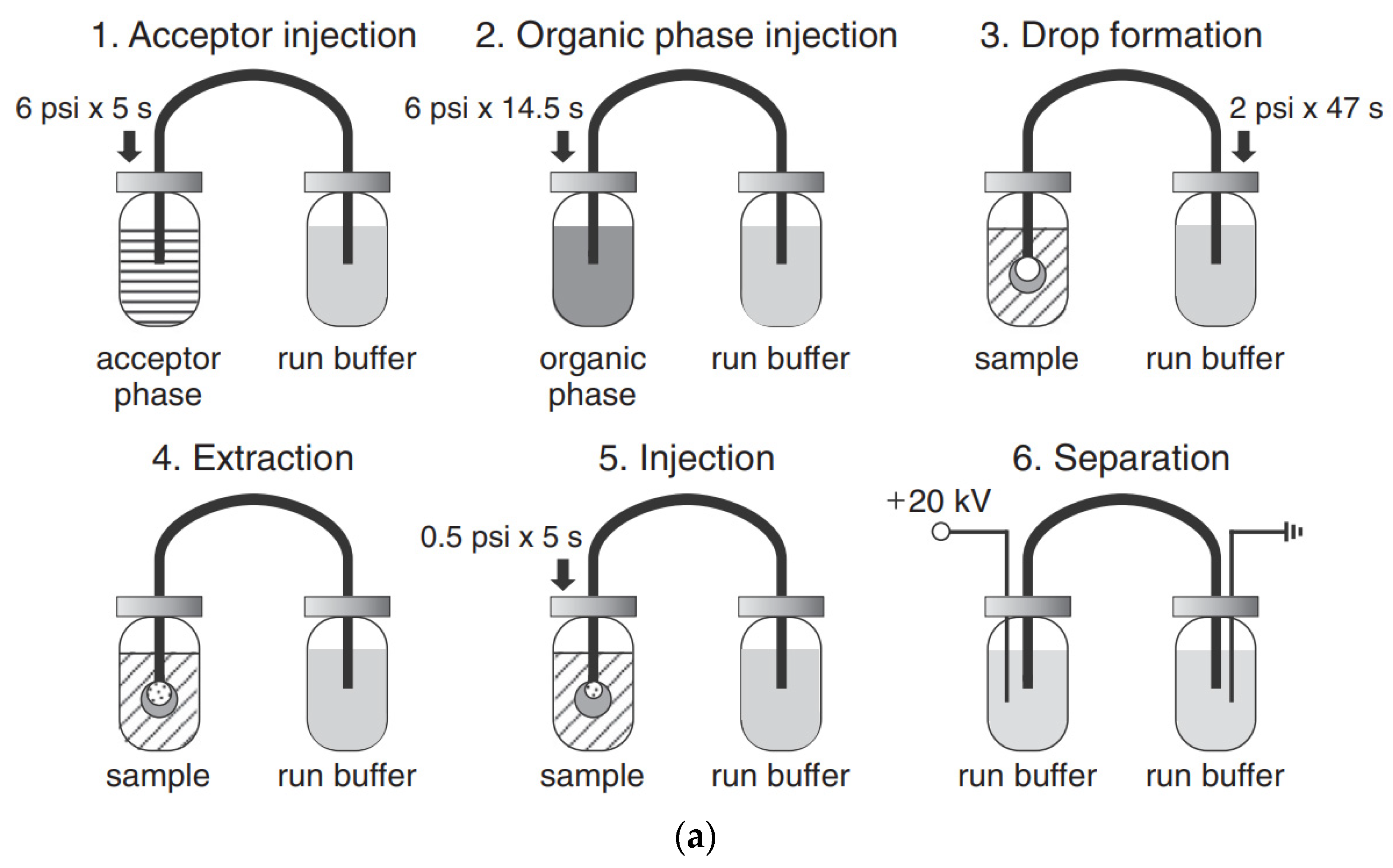
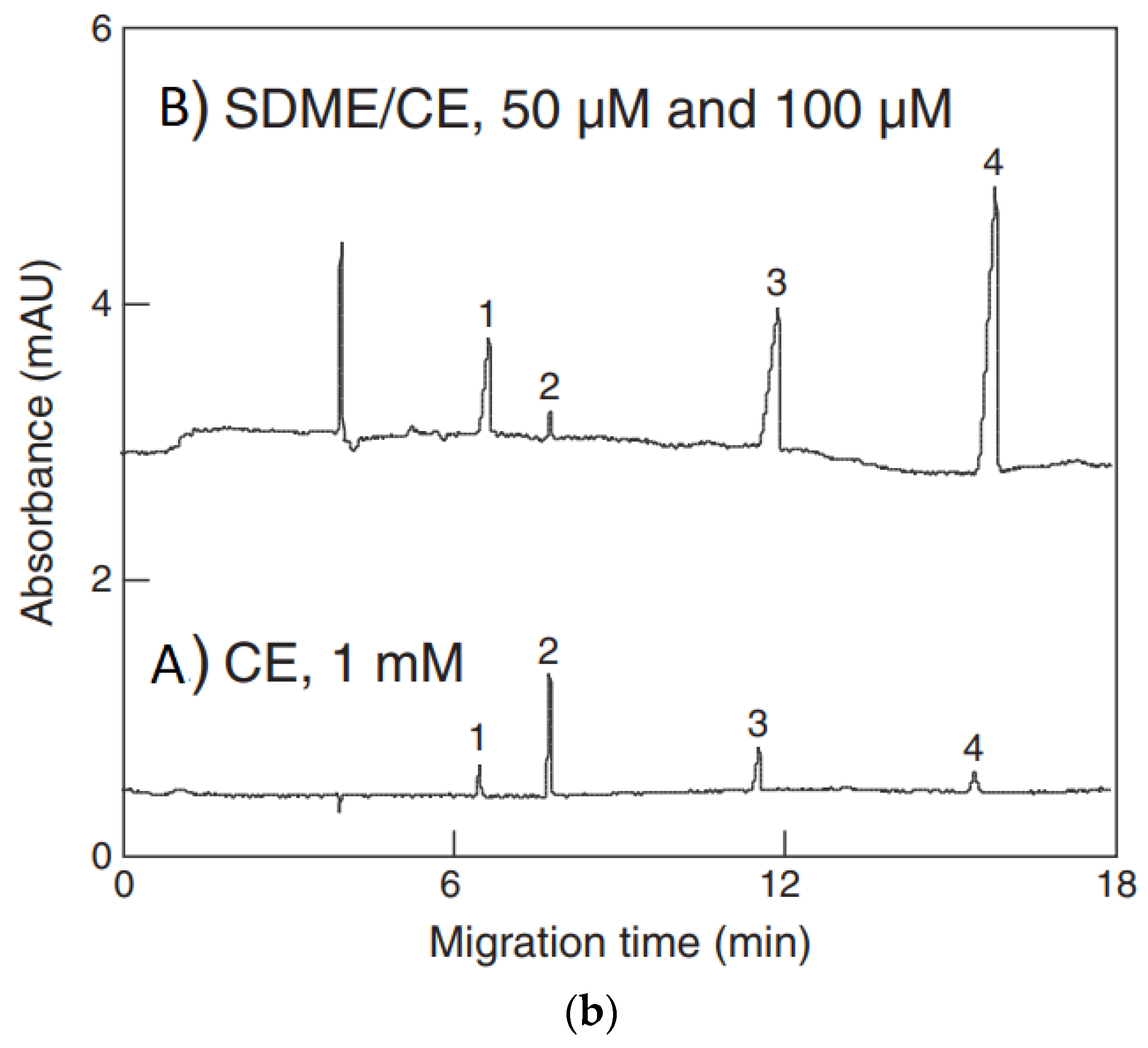
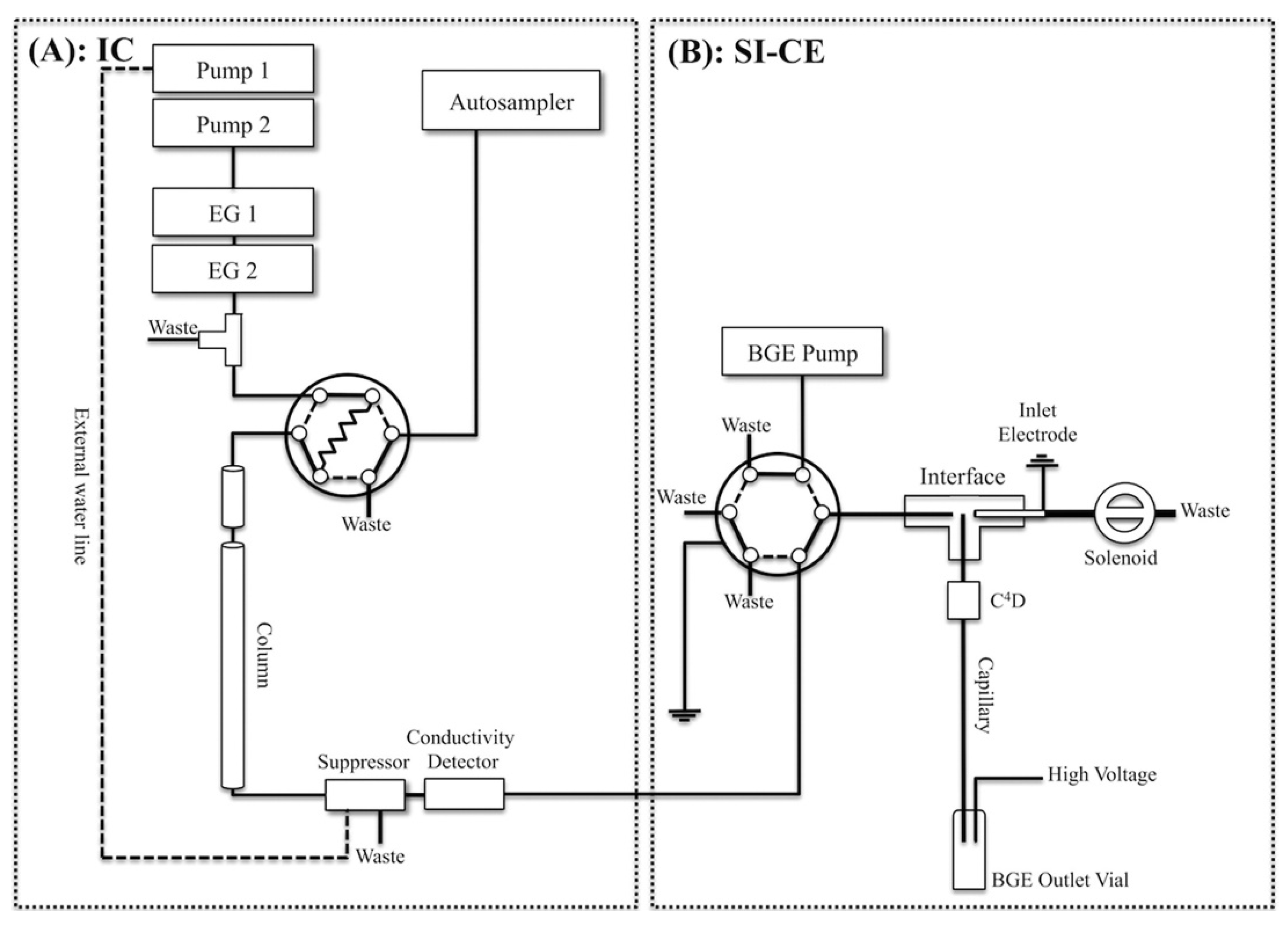
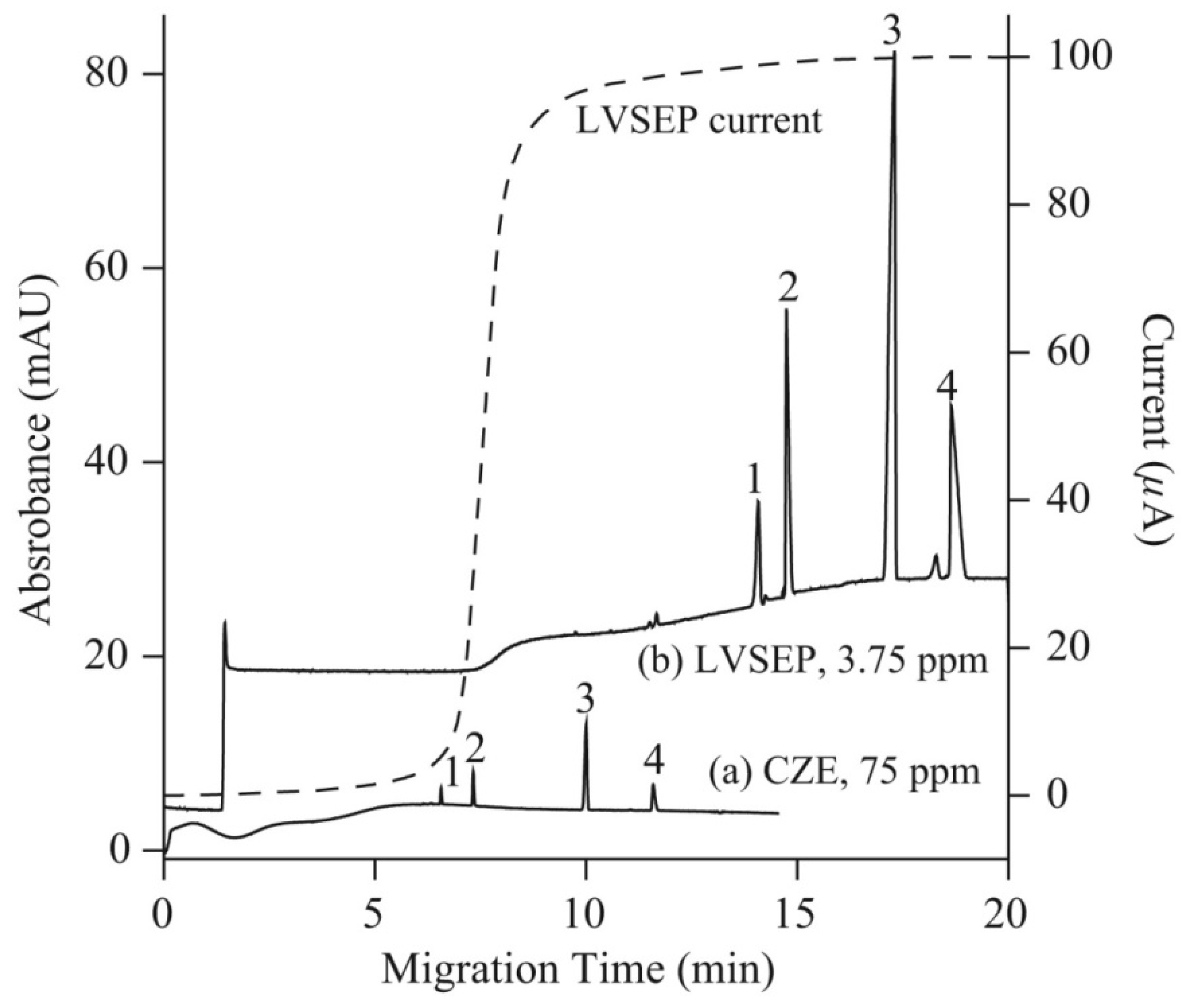
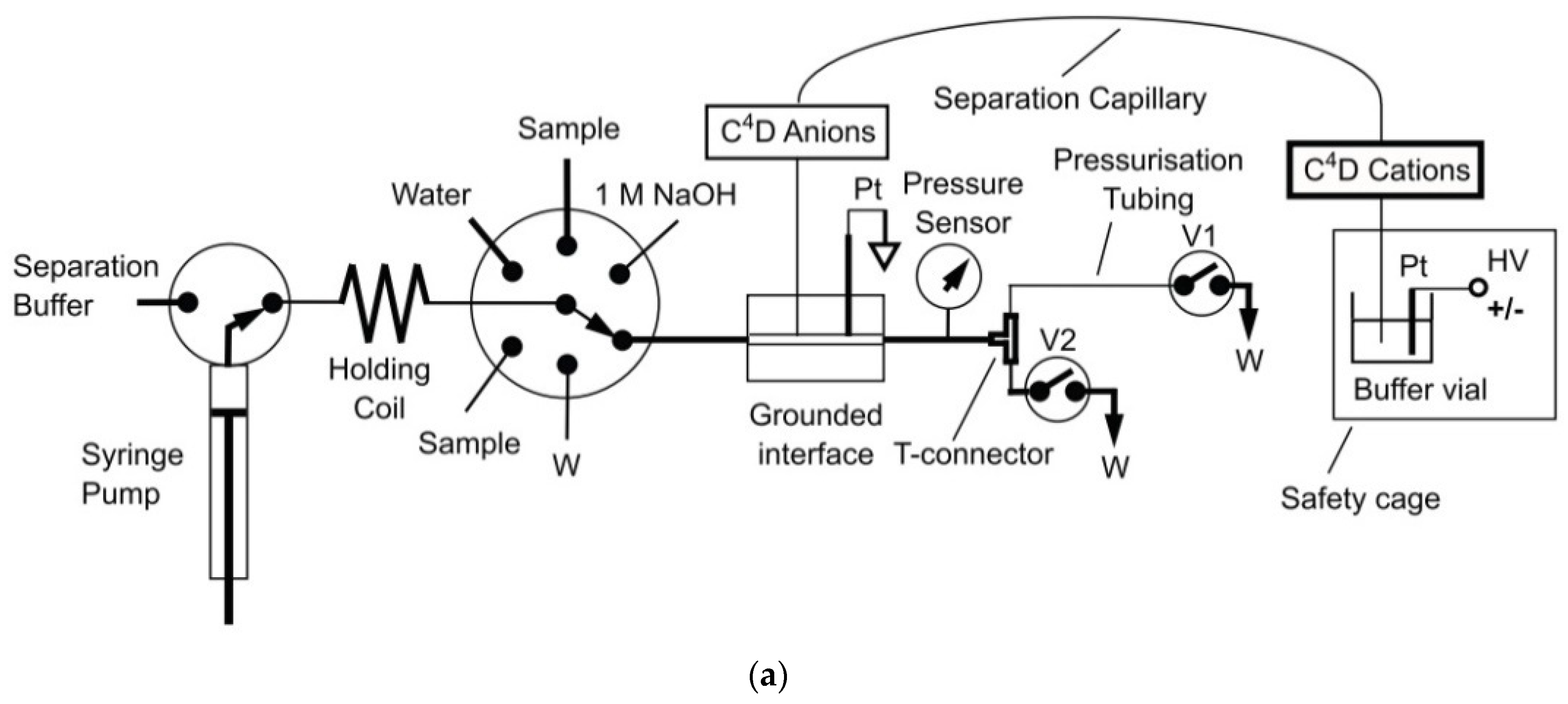

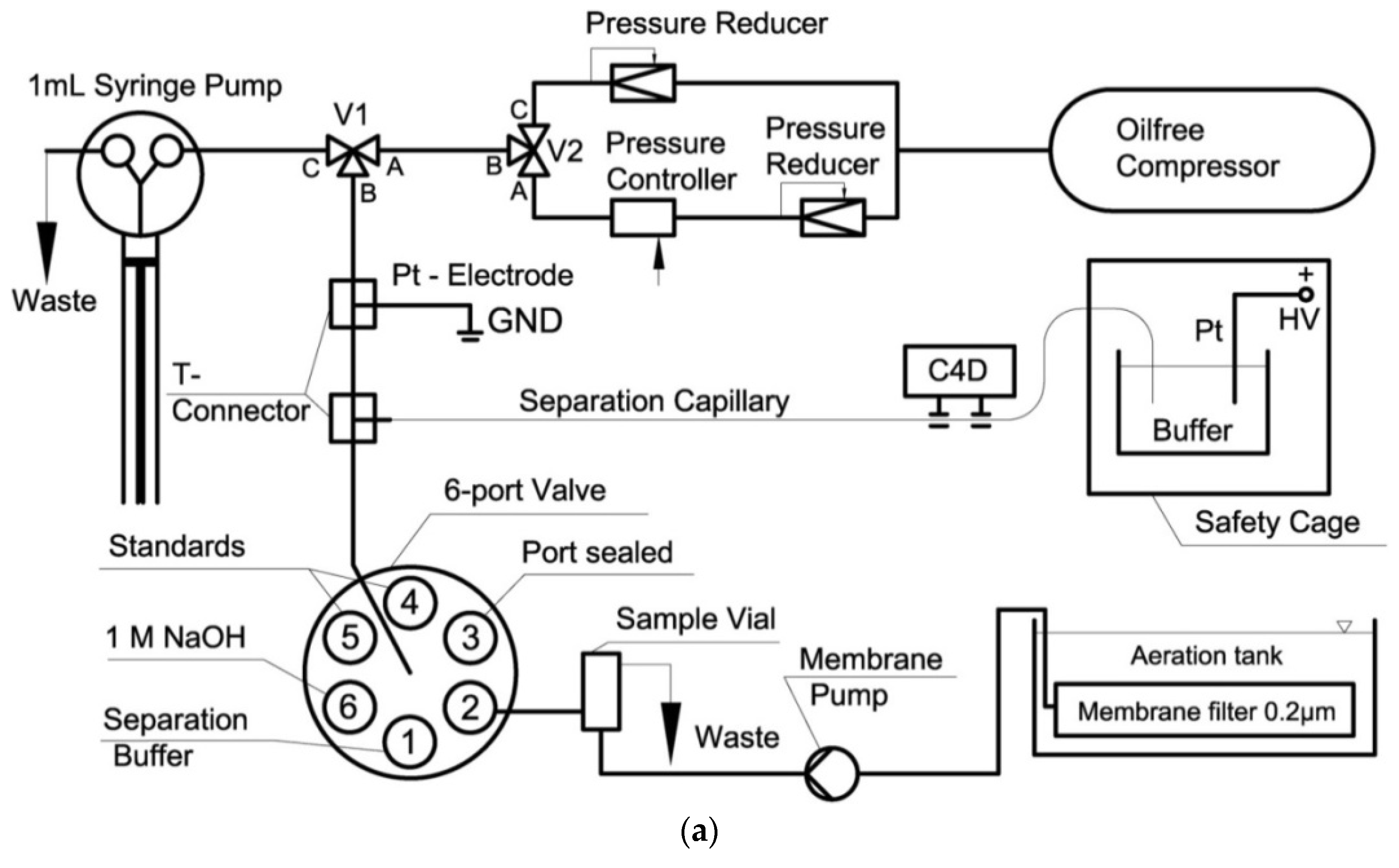
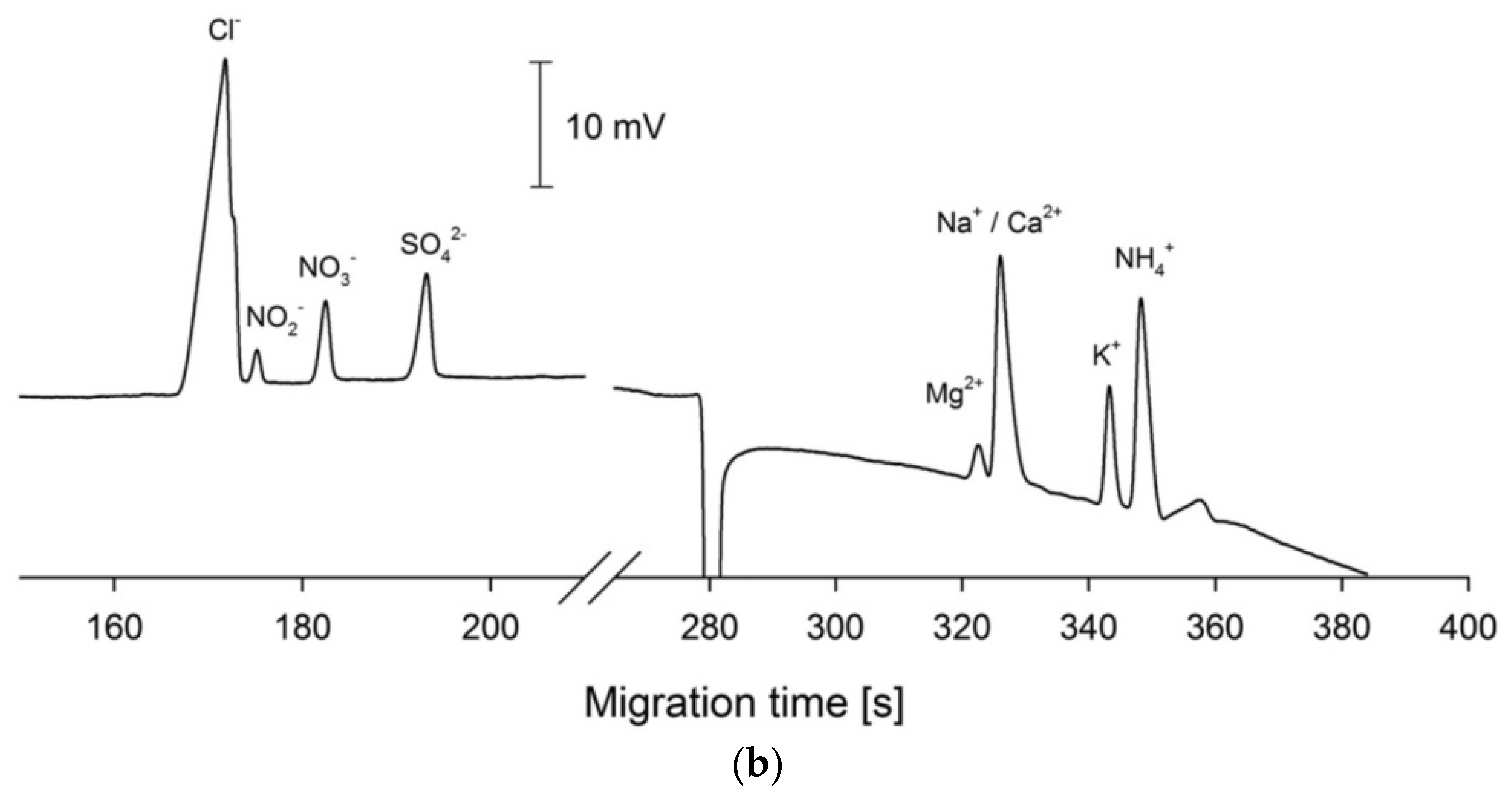

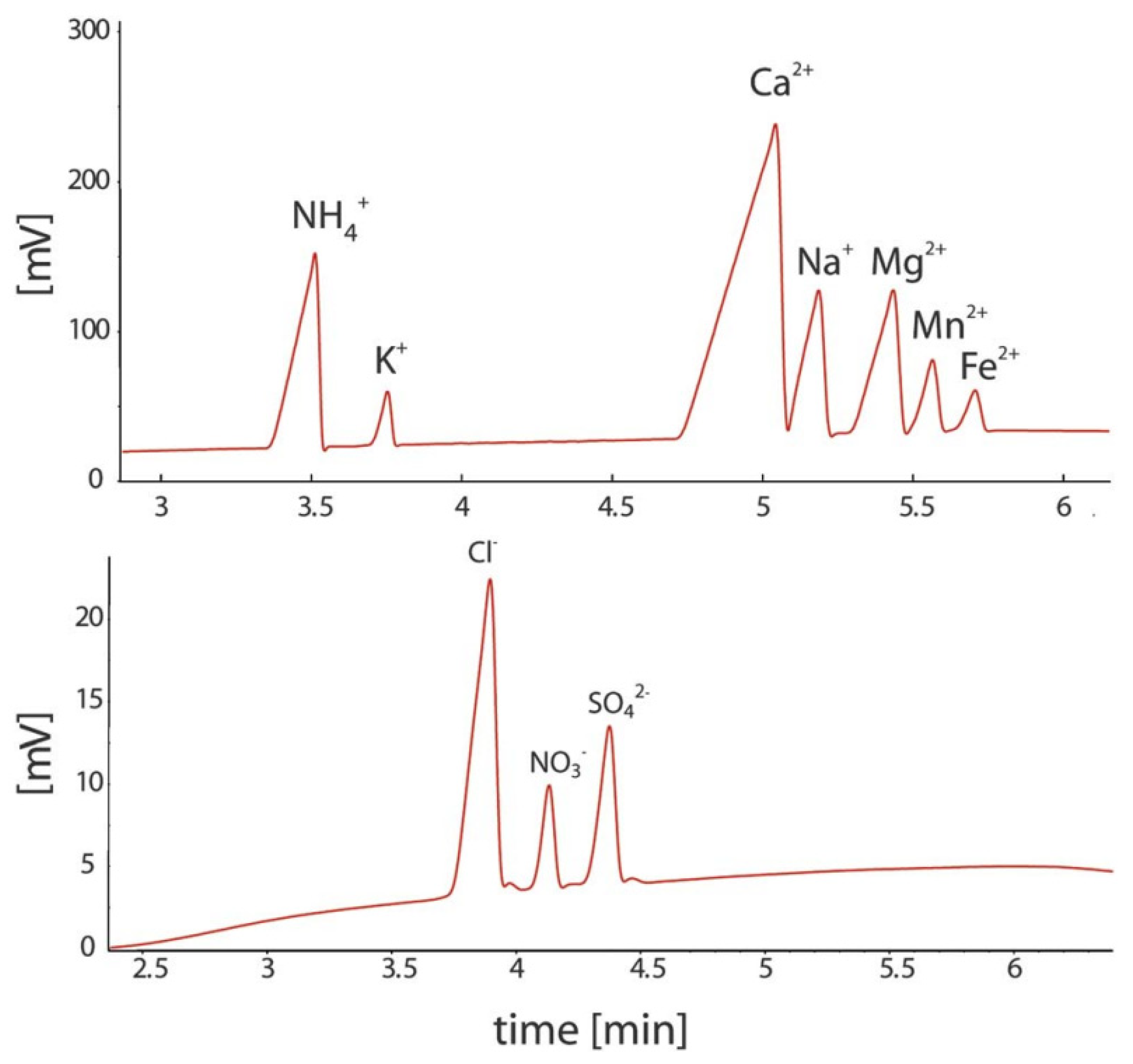

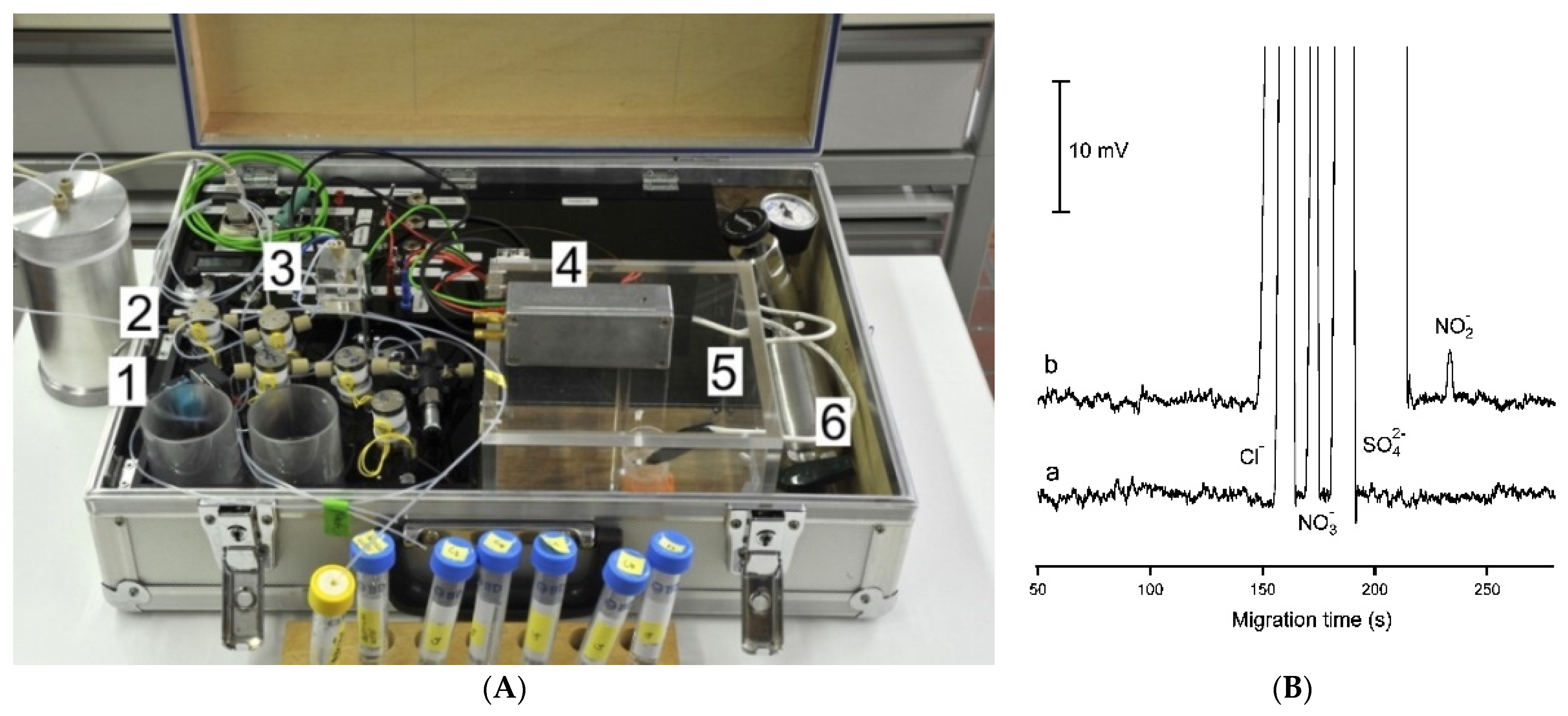
| Analyte(s) | Sample | Sample Pretreatment | Separation Conditions | Detection, LOD | First Author, Year of Publication | Ref. |
|---|---|---|---|---|---|---|
| Anions (Cl−, SO42−) | Highly saline oilfield waters | Dilution | Coated capillary: 60 cm, 50 μm I.D. BGE: 50 mM TRIS, 30 mM SDS, 5% MeOH and 26 mM CrO3 (pH 6.7) V: −10 kV | Indirect UV 280 nm Cl− 2,61 mg⋅L−1, SO42− 2,98 mg⋅L−1 | Donkor, 2015 | [22] |
| Anions (Br−,Cl−, NO3−, SO42−) | Oilfield waters | Dilution | Coated capillary: 60.2 (50) * cm, 50 μm I.D. BGE: 10 mM HPTS, 0.4 M formic acid (pH 2) V: −22.5 kV | Indirect FL—LED 405/520 nm 0.4 mg·L−1 for SO42−, 1.4 mg·L−1 for Cl− | Pei, 2015 | [35] |
| Anions (ClO4−, Cl−, NO3−, SO42−) | Tap and well water | μ-EME with FLM | Capillary: 46 (13) cm, 25 μm I.D. BGE: 10% AcOH (pH 2.2) V: −20 kV | C4D EF 30 | Kuban, 2014 | [43] |
| Anions (ClO4−, Cl−, NO3−, SO42−, NO2−) | Surface, rain tap, snow, potable waters | EME | Capillary: 60 (45) cm, 50 μm I.D. BGE: 7.5 mM His and 40 mM AcOH (pH 4.1) V: −30 kV | C4D 1 mg⋅L−1 tap water 0.25–0.35 mg·L−1 for environmental and potable waters | Kiplagat, 2011 | [53] |
| Anions (BF4−, ClO4−, PF6−, I−, NO3−, Br−, Cl−) | Tap water | Capillary: 60 (50) cm, 75 μm I.D. BGE: DMF–AcOH V: −14 kV | C4D 0.83–3.83 μM | Tian, 2014 | [62] | |
| Anions (total Re, Re(IV), and Re (VII)) | Groundwater | Reduction of Re(VII) to Re(IV) | Capillary: 104 cm, 75 μm I.D. BGE: 10 mM K2CO3 (pH 11) V: 27 kV | ICP-MS 0.02 μg·L−1 for TRe, 0.01 μg·L−1 for Re(VII) | Zhou, 2021 | [69] |
| Anions, chlorine containing (ClO3−,ClO2−, ClO4−, Cl−) | Drinking and swimming pool waters | Capillary: 90 cm, 50 μm I.D. BGE: 100 mM ammonium formate (pH 6.5) V: −20 kV | MS 0.25–2.1 mg⋅L−1 for ClO3− 6 μg·L−1 (for large sample volume) | Gaspar, 2019 | [72] | |
| Anions, sulfur containing (SO42−, S2O32−, S3O62−,vS4O62−, S5O62−) | Tailings pond water | FASS | Capillary: 48.5 (40.0) cm, 50 μm I.D. BGE: 2.00 mM PMA, 0.80 mM HMOH (pH 8.0) V: −20 kV | Indirect UV 350 nm 0.02–0.12 mg·L−1 | Pappoe, 2014 | [21] |
| Anions (Cl−, NO3−, SO42−) Cations (Ca2+, K+, Mg2+, Na+, NH4+) | Cold and hot tap waters, well water | Capillary 60 (51.5) cm, 50 µm I.D. BGE1: 9 mM pyridine, 12 mM glycolic acid, and 5 mM 18-crown-6 ether (pH 3.6) BGE2: PMA (pH 7.7) V: ±20 kV | Indirect UV (DAD) 220, 254 nm 0.05–0.10 mg·L−1 (cations), 0.10 mg·L−1 (anions) | Fellah, 2017 | [17] | |
| Anions (Cl−, NO3−, NO2−, SO42−) Cations (K+, Na+, Ca2+, Mg2+, NH4+) Phosphate As(III) | Ground and surface waters | Capillary: 65 (49) cm, 25 μm I.D. BGE1: 12 mM His,2 mM 18-crown-6 (pH 3.7) V: 15 kV; Capillary: 52 (36) cm, 25 μm I.D. BGE2: 12 mM His (pH 4.0 AcOH), V: −15 kV; Capillary: 52 (36) cm, 25 μm I.D. BGE3: 1 mM His (pH 3.5 AcOH) V: −15 kV; Capillary: 60 (52) cm, 25 μm I.D. BGE4: 12 mM MES, 21 mM Arg, 30 mM CTAB (pH 8.9) V: −20 kV | C4D 2.5–10 μM | Duong, 2015 | [47] | |
| Anions (Cl−, NO3−, SO42−, NO2−, F−, H2PO4−) Cations (NH4+, K+, Ca2+, Na+, Mg2+, Li+) | Tap water sewage | Portable | Capillary: 50 (36) cm, 50 μm I.D. BGE: 12 mM His, 2 mM 18-crown-6 (pH 4 AcOH) V: ±15 kV | C4D 1.5–17 μM | Mai, 2013 | [50] |
| Anions (Cl−, NO3−, SO42−) Cations (Na+, K+, NH4+, Ca2+, Mg2+, Mn2+, Fe2+) | Sediment porewater | Portable | Capillary: 55 cm, 50 μm I.D. BGE: 11 mM His, 50 mM AcOH, 1.5 mM 18-crown-6, 0.1 mM citric acid V:±15 kV | C4D Cations 0.46–1.55 μM Anions 0.28–0.98 μM | Torres, 2013, 2014 | [8,52] |
| Anions (Cl−, NO3−, SO42−, NO2−, F−, PO43−) Cations (NH4+, Na+, K+, Ca2+, Mg2+) | Tap water Lake water | On-site ion analyzer | Coated capillary: 60 (50) cm, 25 μm I.D. BGE: 400 mM Bis-Tris, 400 mM MOPS and 2 mM 18-crown-6 (pH 6.8) V: ±15 kV | C4D 2.1 μM (K+) 6.8 μM (PO43−) | Li, 2021 | [58] |
| Arsenic speciation (As (III), As (V), DMA, MMA, AsB, AsC, 3-NHPAA, 4-NPAA, o-ASA and p-UPAA) | Groundwater | Capillary: 100 cm, 50 μm I.D. BGE: 12 mM NaH2PO4 and 8 mM HBO3 (pH 9.20) V: 30 kV | ICP-MS 19–65 fg As | Liu, 2013 | [67] | |
| Arsenic speciation (As(III), As(V), MMA, DMA) | Tap water | SDME | Capillary: 60 (50) cm, 25 μm I.D. BGE: 15 mM phosphate buffer (pH 10.6) V: 25 kV | UV 200 nm As(III)–0.2 μM, DMA–0.7 μM, MMA–0.1 μM, As(V)–0.2 μM | Cheng, 2013 | [32] |
| Arsenic speciation (As(III), As(V), MMA, DMA) | Spring water | CF-EKS | Capillary: 60 (50) cm, 50 μm I.D., μSiL-FC coated BGE: phosphate buffer (pH 9.6) LE and CHES (pH 9.6) TL V: −20 kV | UV 200 nm 0.08–0.3 μg·L−1 As EFs 6300–45,000-fold | Lee, 2018 | [33] |
| Arsenic speciation (DMA, MMA, As(III), As(V)) | Grandwater, well water, bottled water | Partial evaporation of the sample (50:1) | Capillary: 72 cm, 50 μm I.D. BGE: 57 mM HFIP (pH 10.3) V: 30 kV | ESI-MS 0.02–0.04 μg·L−1 (As) | Dominguez-Alvarez, 2020 | [70] |
| Arsenic speciation (As(III), As(V)) | River sediment | Microwave extraction | Capillary: 60 cm, 100 μm I.D. BGE: 25 mM NaH2PO4—Na2HPO4 (pH 6.6) V: 25 kV | HG-ETAAS As(III)–135 ng·g−1 As(V)–160 ng·g−1 | Deng, 2013 | [74] |
| Arsenic speciation (As(III), As(V), MMA, DMA, AsB) Selenium speciation (Se(IV), Se(VI), SeCys, SeMet, MeSeCys) | Groundwater, tap water | Capillary: 60 cm, 75 μm I.D. BGE: 6 mM NaH2PO4, 9 mM H3BO3 (pH 9.0) V: 25 kV | ICP-MS 0.11−0.37 μg·L−1 for arsenic compounds 1.33−2.31 μg·L−1 for selenium species | Liu, 2014 | [68] | |
| Aresenic speciation (As(III) and As(V)]) Selenium speciation (Se(IV) and Se(VI)) Bromate | Drinking water | PAEKI | Capillary: 110 cm, 50 μm I.D. BGE: 20 mM ammonium carbonate (pH 9.2) V: 30 kV + 50 mbar | ESI-MS/MS 1–3 μg·L−1 | Zhang, 2011 | [71] |
| Bromate | Drinking water | On-line ITP | Capillary: 24 (18) cm, 300 μm I.D. BGE: 50 mM phosphate, 20 mM glycine (pH 2.0), 0.1% MHEC, constant current mode 50 μA | UV 200 nm 0.6 μg·L−1 | Marak, 2012 | [24] |
| Bromate | Tap water | FASS | OT-CEC (coated with TMAPL) Capillary: 50 (41.5) cm 50 μm I.D. BGE: 20 mM Tris–14 mM HClO4 (pH 7.80) V: −20kV | DAD 235 8 μg·L−1 | Guo, 2013 | [25] |
| Bromate | Tap and bottled water | EME | Capillary: 80 (73) cm, 25 μm I.D. BGE: 300 mM AcOH, V: −18 kV | C4D 0.12 μg·L−1 | Zhang, 2016 | [45] |
| Cations (NH4+, K+, Ca2+, Na+, Sr2+, Cd2+, Pb2+; Mg2+; Fe2+, Ni2+, Zn2+, Cu2+) | Mineral, tap and well waters | Dilution in the ratio 1: 10 for tap water | Coated capillary: 60 (50) cm, 75 μm I.D. BGE: 20 mM benzimidazole,75 mM AcOH, 0.6 mM 18-crown-6 (pH 4.22) V: 25 kV | Indirect UV 254 nm 0.015–0.10 mg·L−1 | Kowalski, 2017 | [18] |
| Cations (NH4+, K+, Ca2+, Na+, Mg2+, Pb2+) | Natural, and potable waters, wastewater | Capillary: 64.5 (56) cm, 75 μm I.D. BGE: 15 mM imidazole, 8 mM malonic acid, 2 mM 18-crown-6 ether, 10% v/v MeOH (pH 4.35) V: −20 kV | Indirect UV 214 nm 0.023–0.084 mg·L−1 | Varden, 2017 | [19] | |
| Cations (K+, Na+, Ca+2, Mg+2) | Sea water | Dilution 1:10 (v/v) | Capillary: 50 (40) cm, 50 μm I.D. BGE: 200 mM 2,4,6-trimethylpyridine, 250 mM lactic acid, 5% v/v MeOH (pH 4.5) V:25 kV | Indirect UV 230 nm ~10 mg·L−1 | Lancioni, 2021 | [20] |
| Cations (Ca2+, Mg2+, Cu2+, Zn2+, Ni2+, Co2+, Mn2+, Cd2+, Pb2+) | River water | Derivatization | Capillary: 60 (46.5) cm, 50 μm I.D. BGE: 50 mM borate buffer (pH 10.09), 0.05% PB, 1.0 mM DOTA V: 20 kV | LIF low ng·L−1 levels | Saito, 2011 | [34] |
| Cations (Mn2+, Cd2+, Zn2+, Co2+, Pb2+, Cu2+, Ni2+) | Drinking and sea water | EME | Capillary: 50 (37) cm, 50 μm I.D. BGE: 5.2 M AcOH V: 20 kV | C4D 1–2.6 nM | Silva, 2018 | [41] |
| Cations (Na+, K+, Li+, Ca2+, Mg2+, NH4+) | Ocean and lake waters | Dilution | Capillary: 64(43) cm, 50 μm I.D. BGE: 5 M AcOH, 10 mM 18-crown-6 and 10% ACN V: 30 kV | C4D 1.0 μM | Ferreira, 2018 | [42] |
| Cations (Mn2+, Cd2+, Zn2+, Co2+, Pb2+, Cu2+, Ni2+) | Tap water | EME | Capillary: 50 (37) cm, 50 μm I.D. BGE: 20 mM l-His and 17 mM AcOH (pH 5.6) V: 25 kV | C4D 25–200 nM | Kuban, 2011 | [46] |
| Cations (Na+, K+, NH4+, Ca2+, Mg2+) | Porewater of lake sediment core | Micro-injection | Capillary: 60 (49) cm, 25 μm I.D., BGE: 30 mM MES/His (pH 6), 2 mM 18-crown-6 V: −30 kV | C4D 10 μM | Saiz, 2015 | [51] |
| Cations (Na+, K+, Li+, Ca2+, Mg2+, NH4+) | Drinking water and soil extracts | Capillary: 126 × 8 mm I.D. channels and 49.1 cm in length BGE: 20 mM MES/His (pH 6.1), 2 mM 18-crown-6. V: 286 mV/cm | C4D NH4+–3.2 μM Na+–2 μM | Nakatani, 2019 | [60] | |
| Fluoride | Seawater | 10-fold dilution/tITP | Capillary 87.4 (75) cm, 75 µm I.D. BGE: 5 mM PDC (pH 3.5), 0.03% m/v HPMC V: 23 kV | indirect UV 200 0.024 mg·L−1 | Fukushi, 2018 | [26] |
| Mercury speciation (Hg(II), MeHg, EtHg and PhHg) | Tap, sea and surface waters | DLLME | Capillary: 60.2 (50) cm, 75 μm I.D. BGE: of 75 mM boric acid, 10% (v/v) MeOH (pH 9.0) V: 20kV | UV 210 nm Hg(II)–1.5, MeHg–1.79, EtHg–1.62 and PhHg–0.23 μg·L−1 EFs 46, 102, 118 and 547 | Yang, 2014 | [27] |
| Mercury speciation Hg(II) MeHg, EtHg and PhHg | River and lake waters | HF-LLLME | Capillary: 48.5 (40) cm, 50 μm I.D. BGE: 35 mM borate buffer (pH 9.10) V: 25 kV | UV 200 nm Sub μg·L−1 level EF 2195 | Li, 2015 | [28] |
| Mercury speciation(Hg(II), MeHg, EtHg and PhHg) | River and lake waters | PT-LLLME and LVSS | Capillary: 64.5 (56) cm, 50 μm I.D. BGE: 35 mM borate buffer (pH 9.10) V: 25 kV | UV 200 nm Sub μg·L−1 level EFs up to 12,138 | Li, 2011 | [29] |
| Mercury speciation (Hg(II), MeHg, EtHg and PhHg) | River water | HF-LLLMME | Capillary: 48 cm, 75 μm I.D. BGE: 100 mM borate buffer (pH 9) V: 15 kV | UV 210 nm 0.07–1.0 μg·L−1 (as Hg) EFs: Hg(II)–103, MeHg–265, EtHg–511 and PhHg–683 | Chen, 2013 | [30] |
| Mercury speciation (Hg(II), MeHg, EtHg) | Tap water | DSPE and FASI | Capillary: 90 cm, 75 μm I.D. BGE: 50 mM H3BO3—12.5 mM Na2B4O7 (pH 9.20) V: 12 kV | ICP-MS 9–11 ng·L−1 | Chen, 2016 | [65] |
| Mercury speciation (Hg(II) and MeHg) | River water | - | Capillary: 16 cm, 75 μm I.D. BGE: 30 mM boric acid and 5% (v/v) MeOH (pH 8.6) V: 21 kV | ICP-MS 9.7 mg·L−1 MeHg 12.0 mg·L−1 Hg(II) | Li, 2011 | [66] |
| Selenium speciation (Se(IV) and Se(VI)) | River, spring, and tap waters | SPME and FASS | Capillary: 64.5 (50) cm, 75 μm I.D. BGE: 0.2 M Tris-phosphate (pH 2.5), 0.1 mM CTAB V: −20 kV | UV 200 nm Se(IV)–57 ng·L−1 EF 41367 Se(VI)–ng·L−1 71 EF 61935 | Duan, 2012 | [31] |
| Selenium speciation (Se(IV), Se(VI)m SeMet, SeCys2) | Wastewater | MSPE | Capillary: 80 cm, 75 μm I.D. BGE: 20 mM phosphate buffer (pH 10.6), 0.2 mM CTAB V: 25 kV | ETAAS Se(VI)–0.18 μg·L−1, Se(IV)–0.17 μg·L−1 | Yan, 2015 | [73] |
| Analyte(s) | Sample | System Configuration | Separation Conditions | Detection, LOD | First Author, Year of Publication | Ref. |
|---|---|---|---|---|---|---|
| Anion HPO42− Cation Ca2+ | River water | On-column complexation | Capillary: 55.0 (48.5) * cm, 50 μm I.D. BGE: 10 mM PDCA, 0.75 mM TTAB (pH 7.0) V: −20 kV | UV 214 nm 5 μM for [Ca(PDCA)2]2− 2 μM for HPO42− | Wang, 2011 | [23] |
| Anions (NO3−, SO42−) Cations (K+, NH4+) | Fertiliser solution | Dual capillary system | Capillary: 10.5 (8.0) cm, 25 μm I.D. BGE: 500 mM AcOH, 20 mM Tris, 2 mM 18-crown-6 (pH 3.3) V: ±10 kV | C4D 6.9 μM K+ 10.6 μM NH4+ | Opekar, 2016 | [44] |
| Anions (Cl−, NO3−, SO42−, NO2−, F−, PO43−) Cations (Na+, K+, Li+, Ca2+, Mg2+, NH4+) | Creek water | SIA-CE | Capillary: 60 (35) cm, 50 μm I.D. BGE:12 mM His, 2 mM 18-crown-6 (pH 4) V: ±20 kV | C4D Anions: 0.7–2.0 μM Cations: 13–40 μM | Mai, 2010 | [48] |
| Anions (NO3−, NO2−, Cl−, Br−, F-, SO42−, PO43−, ClO4−, ClO3−, CrO42−, MoO42−) Cations (NH4+, K+, Na+, Mg2+, Ca2+, Mn2+, Zn2+, Sr2+, Cd2+, Fe2+) | Tap and process waters | Dual capillary—SI | LPA coated capillaries: Cations—55 (35) cm, 50 μm I.D., Anions—50 (28) cm, 50 μm I.D., BGE: 50 mM AcOH,10 mM His, 2.5 mM 18-crown-6 (pH 4.2) V: ±30kV | C4D Anions: 5–61 μg·L−1 Cations: 13–40 μg·L−1 | Gaudry, 2013 | [54] |
| Anions (NO3−, NO2−) Cation (NH4+) | Contaminated groundwater | Dual capillary system | Capillary: 55 (40) cm, 50 μm I.D. BGE: 12 mM His, 2 mM 18-crown-6 (pH 4) V: ±15 kV | C4D 5.0 μM NH4+ 6.0 μM NO3− 7.5 μM NO2− | Pham, 2014 | [55] |
| Anions (Cl−, NO3−, SO42−) Cations (K+, Na+, Mg2+, Ca2+) | Mineral and tap waters | GEMBE | Capillary: 5.0 cm, 15 μm I.D. BGE: 100 mM AcOH and 10 mM His (pH 3.76) V: 20 kV | C4D Anions: 0.34–1.13 mg·L−1 Cations: 0.76–3.09 mg·L−1 | Flanigan, 2010 | [57] |
| Anions (Cl−, NO3−, SO42−) Cations (NH4+, K+, Na+, Ca2+, Mg2+, Mn2+, Zn2+, Cd2+, Ba2+ | Tap water | SIA/Dual single-end injections | Capillary: 50 cm, 10 μm I.D, Leff for cations—43 cm and for anions—35 cm; BGE: 12 mM His, 2 mM 18-crown-6 (pH 4) V: 20 kV | Dual C4D Anions: 1.5–2.0 μM Cations: 0.3–1.5 μM | Mai, 2012 | [58] |
| Anions (NO3−, NO2−) Cation (NH4+) | Water quality monitoring after wastewater treatment | SIA-CE | Capillary: 68.0 cm, 20 μm I.D. BGE: 100 mM His, 100 mM MES, 0.13 mM CTAB, 1.5 mM 18-crown-6 (pH 6) V: 24 kV | C4D 0.03 mg⋅L−1 NO2−, 0.08 mg⋅L−1NO3−, 0.11 mg⋅L−1 NH4+ | Fuiko, 2019 | [61] |
| Anions (Cl−, Br−, NO3−, NO2−, SO42−, PO43−) Cations (NH4+, K+, Na+, Li+, Mg2+, Ca2+) | Drinking water (domestic well) | DOI dual opposite end injection | PVA coated capillary: 60 cm, 50 μm I.D. BGE: 15 mM PMA, 10 mM citric acid, 2 mM 18-crown-6 (pH 3.70 adjusted with His) V: 30 kV | C4D Anions: 0.076–2.51 mg·L−1 Cations: 0.075–2.33 mg·L−1 | Neaga, 2014 | [62] |
| Anions (Cl−, NO3−, SO42−) Cations (NH4+, Na+, K+, Ca2+, Mg2+, Mn2+, Zn2+, Cu2+) | Sediment porewater, well and mining pond water | Dual-channel portable | Capillary: 90 (80) cm, 25 μm I.D. BGE for anions: 7.5 mM His and 40 mM AcOH BGE for cations: 9 mM His, 4.6 mM lactic acid, 25 mM AcOH, 1mM 18-crown-6 V: ±25 kV | C4D Anions: 10–12 μM Cations: 2.8–4.8 μM | Koenka, 2016 | [63] |
| Anions (Cl−, NO3−, SO42−) Cations (Na+, K+, NH4+, Ca2+, Mg2+) | Mineral and tap waters | CFM | Capillary: 35.0 (20 and 15) cm, 25 μm I.D. BGE: 18 mM His, 130 mM malic acid, 100 mM DDAPS, 3 mM18-crown-6 (pH 3.6) V: 30 kV | C4D Anions: 0.4–0.6 mg·L−1 Cations: 0.4–0.6 mg·L−1 | Yamamoto, 2019 | [85] |
| Analyte(s) | Sample | Chip | Separation Conditions | Detection, LOD | First Author, Year of Publication | Ref. |
|---|---|---|---|---|---|---|
| Ammonium | Wastewater | CZE and ITP-CZE PMMA | Channel C1—59 mm × 0.2 mm–0.5 mm × 0.14 mm–0.2 mm; channel C2—56 mm × 0.2 mm–0.5 mm × 0.14 mm–0.2 mm) BGE1: LE: 1.25 mM ethylenediamine, 3.75 mM acetic acid, 50 mM 18-crown-6, 0.1% v/v PEG, pH 5.4; TE: 10 mM sodium acetate, 10 mM AcOH, 0.1% v/v PEG (pH 4.8), I = 15 µA BGE2: 50 mM AcOH, 25 mM 18-crown-6 and 4 mM tartaric acid, 0.1% v/v PEG (pH 3.0) I = 25 µA | C4D 20 µg·L−1 CZE 40 µg·L−1 ITP-CZE | Luc, 2011 | [99] |
| Anions (Cl−, NO3−, SO42−) | Drinking water | PMMA | Channel: 85 (65) mm, 50 × 50 µm BGE: 18 mM aspartate (pH 4.15), 0.1% MHEC, 5.94 mM Bis-tris propane, 100 mM DDAPS I: 40 μA | C4D 40–120 µg·L−1 | Masar, 2012 | [97] |
| Anions (Cl−, NO3−, F−, SO42−, SCN−, PO43−) | Mineral water, tap water | PDMS | Channel: 65 mm, 100 µm BGE: 50 mM MES/His (pH 6.0), 0.5% PVP V: 2 kV | C4D with in-plane electrodes 3.6–14.7 μM | Koczka, 2016 | [100] |
| Anions (Br−, Cl−, NO3−, NO2−, F−, SO42−) Cations (NH4+, K+, Na+, Li+, Ca2+, Mg2+) | Bottled drinking water | PMMA | Channel: 85 (65) mm, 50 × 50 µm BGE: 30 mM MES/His (pH 6), 2mM 18-crown-6 V: ±4 kV | C4D dual top–bottom cell 0.3 µM cations, 0.15 µM anions | Mahabadi, 2010 | [101] |
| Anions (Cl−, NO3−, NO2−, SO42−) | Aquarium, river water | Borosilicate glass | Channel: 33 mm, 10 × 100 µm BGE: 30 mM latic acid and 15 mM His (pH 3.8) V: −1.0 kV | C4D 2.0 to 4.9 μM | Freitas, 2016 | [102] |
| Cations (K+, Na+, Li+, Ca2+, Mg2+, Zn2+, Cd2+, Cu2+) | River water | PDMS/PET | Channel: 50 mm, 50 × 50 µm BGE1: 10 mM MES, 10 mM His BGE2: 0.1 M acetic buffer pH 4.0 V: 5kV | C4D with ITO-coated films electrodes 5.8 μM K+, 8.0 μM Na+, 14.3 μM Li+ | Yan, 2015 | [98] |
| Cations (Ag+, Hg2+) | Tap water and river water | Quartz | Channel: 23 mm, 104 × 48 μm BGE: phosphate buffer saline (pH 7.4) V: 250 V | LED LIF 0.038 nM Ag+, 0.054 nM Hg2+ | Chen, 2019 | [105] |
| Nitrite | Well water | PDMS | Channel: 50 mm, 15 × 15 μm BGE: 5 mM phosphate (pH 7.5), 200 mM CTAB V: −1.0 kV | Amperometric detection pencil graphite electrode 2.8 μM | Da Silva, 2017 | [103] |
| Nitrite | Drinking water | PDMS | Channel: 50 mm, 15 × 15 μm BGE: 5 mM phosphate (pH 6.85), 200 mM CTAB V: −1.2 kV | Amperometric detection screen-printed carbon-based electrode 8.2 μM | Petroni, 2017 | [104] |
| Perchlorate | Drinking water | PDMS | Channel: 20 mm, 50 × 50 µm BGE:10 mM nicotinic acid, 1.0 mM TDAPS (pH 3.6); V: −700 V | C4D 5.6 ± 1.7 µg·L−1 | Gertsch, 2010 | [96] |
Publisher’s Note: MDPI stays neutral with regard to jurisdictional claims in published maps and institutional affiliations. |
© 2021 by the authors. Licensee MDPI, Basel, Switzerland. This article is an open access article distributed under the terms and conditions of the Creative Commons Attribution (CC BY) license (https://creativecommons.org/licenses/by/4.0/).
Share and Cite
Poboży, E.; Trojanowicz, M. Application of Capillary Electrophoresis for Determination of Inorganic Analytes in Waters. Molecules 2021, 26, 6972. https://doi.org/10.3390/molecules26226972
Poboży E, Trojanowicz M. Application of Capillary Electrophoresis for Determination of Inorganic Analytes in Waters. Molecules. 2021; 26(22):6972. https://doi.org/10.3390/molecules26226972
Chicago/Turabian StylePoboży, Ewa, and Marek Trojanowicz. 2021. "Application of Capillary Electrophoresis for Determination of Inorganic Analytes in Waters" Molecules 26, no. 22: 6972. https://doi.org/10.3390/molecules26226972
APA StylePoboży, E., & Trojanowicz, M. (2021). Application of Capillary Electrophoresis for Determination of Inorganic Analytes in Waters. Molecules, 26(22), 6972. https://doi.org/10.3390/molecules26226972







